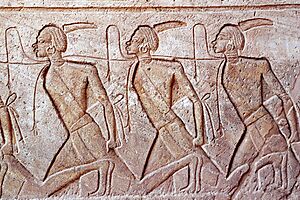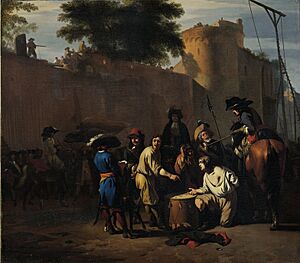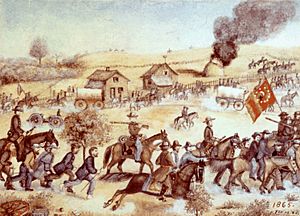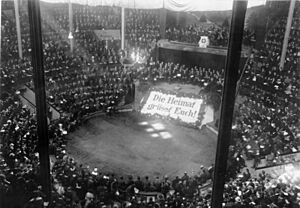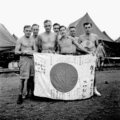Prisoner of war facts for kids
A prisoner of war (often called a POW) is a person captured and held by an enemy country during or right after a war. The idea of "prisoner of war" has been around since the 1600s. Countries might hold POWs for many reasons. These include keeping them from fighting again, showing military success, or gathering information. Sometimes, POWs are held until the fighting stops and they can return home.
Contents
Ancient Times and Early History
In ancient times, prisoners of war were often treated very harshly. Sometimes they were forced into labor or even killed. For example, early Roman gladiators were sometimes prisoners of war. These gladiators were often grouped by where they came from, like Samnites or Gauls. In ancient stories like Homer's Iliad, soldiers sometimes offered money to their enemies to spare their lives after being defeated. However, these offers were not always accepted.
Victors in ancient battles often treated enemy soldiers and civilians similarly. Women and children were sometimes spared. In the 4th century AD, a kind bishop named Acacius of Amida helped Persian prisoners. They were suffering in his town and were going to be forced into labor. Bishop Acacius sold valuable church items to buy their freedom and let them go home. He was later recognized as a saint for his actions.
Prisoners in the Middle Ages
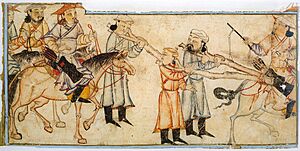
During the Middle Ages, stories tell of Geneviève, a nun who later became the patron saint of Paris. She asked King Childeric I to treat prisoners of war kindly during a siege in 464, and he agreed. Later, King Clovis I also freed captives after Genevieve asked him to.
At the Battle of Agincourt in 1415, King Henry V of England's army killed many French prisoners. He worried that the prisoners might rejoin the fight if French reinforcements arrived.
Some wars in the later Middle Ages were fought with great cruelty. For example, during the crusades in the 11th and 12th centuries, people in conquered cities were often killed. However, noblemen who were captured could often hope to be ransomed. Their families would pay large sums of money to their captors to get them back.
In Feudal Japan, there was no custom of ransoming prisoners. Most captured soldiers expected to be killed. The Aztecs in the 13th century often captured people from neighboring tribes. These prisoners were sometimes used in religious ceremonies.
During the early Muslim conquests, many prisoners were taken. Most were either ransomed or became laborers. Christians captured during the Crusades also faced similar fates. Muhammad, a key figure in Islam, taught that the government should provide food and clothing for captives. This was true regardless of their religion.
Naval forces from both Christian and Muslim countries sometimes forced prisoners of war to become galley slaves. These slaves rowed large ships. At the Battle of Lepanto in 1571, 12,000 Christian galley slaves were freed from the Ottoman Empire.
Modern Rules for Prisoners of War
In Europe, the way prisoners of war were treated became more organized between the 16th and 18th centuries. Before, a prisoner was often seen as the personal property of the person who captured them. But over time, captured enemy soldiers were increasingly seen as property of the state. Countries started to control how prisoners were captured, held, and eventually released.
International agreements, called the cartel system, began to regulate how countries would exchange prisoners. The 1648 Peace of Westphalia, which ended the Thirty Years' War, set a rule. It stated that prisoners of war should be released and allowed to go home without a ransom once the fighting ended.
A special agreement called the parole system also developed. This was for captured officers. An officer could give his word as a gentleman not to escape or fight again. In return, he might get better living conditions or even be sent home.
Early Captivity Stories in North America
Early stories exist about European settlers captured by Native American tribes in North America. Mary Rowlandson wrote about her capture in 1676 during King Philip's War. These stories became popular and influenced early American literature. Native Americans continued to capture Europeans for labor or as bargaining tools into the 19th century. One example is John R. Jewitt, a sailor captured by the Nuu-chah-nulth people.
Prisoner Camps and Exchanges
The first known camp built specifically for prisoners of war was at Norman Cross Prison in England. It opened in 1797 during the French Revolutionary Wars and Napoleonic Wars. This camp was designed to treat prisoners humanely. The British government made sure prisoners received good quality food. However, some prisoners still died from starvation after gambling away their food.
During the Battle of Leipzig, a city cemetery was used as a camp for about 6,000 POWs. They lived in burial vaults and used coffins for firewood. Food was extremely scarce. These terrible conditions led to a city-wide sickness after the battle.
The long wars of the late 1700s and early 1800s led to a system for exchanging prisoners. This system, called a cartel, helped reduce the number of prisoners held. It also helped countries get skilled soldiers back.
Prisoners in the American Civil War
At the start of the American Civil War, a system called parole was used. Captured soldiers promised not to fight again until they were officially exchanged. They were held in camps run by their own army. However, this system broke down in 1863 when the Confederate side refused to exchange Black prisoners.
Later, in 1864, the Union side rejected an offer to restart exchanges. They believed they could afford to keep their men captive, but the Confederacy could not. As a result, about 56,000 of the 409,000 POWs died in prisons during the war. This was nearly 10% of all deaths in the conflict. For example, at Camp Sumter (Andersonville), 13,000 out of 45,000 Union prisoners died.
Improving Prisoner Treatment: The Geneva Conventions
Throughout the 19th century, there were growing efforts to improve how prisoners were treated. International meetings, like the Brussels Conference of 1874, aimed to prevent cruel treatment. These efforts led to new international laws. These laws stated that prisoners of war must be treated humanely and with respect.
The Hague Convention of 1907 and later the 1929 Geneva Convention set out detailed rules. These rules were greatly updated in the Third Geneva Convention in 1949.
Who is a Protected Prisoner of War?
Under the 1949 Geneva Conventions, captured military personnel, some guerrilla fighters, and certain civilians are considered protected persons. This means they have specific rights from the moment they are captured until they are released. Taking away these rights can be a war crime.
To be a protected prisoner of war, a person must meet certain conditions. They must be part of a military chain of command, wear a clear uniform, carry their weapons openly, and follow the rules of war. The Convention also protects people who spontaneously take up arms to defend their non-occupied territory from an invading enemy.
What Rights Do Prisoners of War Have?
The Third Geneva Convention states that prisoners of war must:
- Be treated kindly and with respect.
- Be allowed to tell their families and the International Committee of the Red Cross (ICRC) that they have been captured.
- Be able to communicate regularly with relatives and receive packages.
- Receive enough food, clothing, housing, and medical care.
- Be paid for work they do. They cannot be forced to do dangerous, unhealthy, or humiliating work.
- Be released quickly after the war ends.
- Only be required to give their name, date of birth, rank, and service number.
If a prisoner is wounded or sick, the ICRC helps them. Countries that break these rules can be punished. For example, after World War II, German and Japanese military leaders were tried at the Nuremberg and Tokyo Trials. They were punished for crimes like murder and mistreatment of people during the war.
U.S. Code of Conduct for Captured Soldiers
The The United States Military Code of Conduct was created in 1955 for U.S. service members who become prisoners. It was made after the Korean War to help soldiers know how to act if captured. The Code reminds them that the chain of command still applies. It also requires them to resist giving information to the enemy beyond their name, rank, and service number.
Since the Vietnam War, the U.S. military uses the term "Enemy Prisoner of War" (EPW) for captured enemy soldiers. This helps distinguish them from U.S. captives.
Prisoners of War in World War I

During World War I, about eight million men surrendered and were held in POW camps. All nations promised to follow the Hague rules for fair treatment. Generally, POWs had a much higher chance of survival than soldiers who were not captured. Individual surrenders were rare; usually, large groups of soldiers surrendered together. For example, at Tannenberg, 92,000 Russians surrendered.
The German Empire held 2.5 million prisoners, and Russia held 2.9 million. Britain and France held about 720,000. The most dangerous time for POWs was during the surrender itself, when helpless soldiers were sometimes killed by mistake. Once prisoners reached a POW camp, conditions were often better than in later wars. This was partly thanks to the International Red Cross and inspections by neutral countries.
However, conditions were very difficult in some places, especially in Russia and the Ottoman Empire. Many prisoners died from disease and lack of food. For example, a quarter of the over 2 million POWs held in Russia died. Some 11,800 British soldiers captured by the Ottomans in Mesopotamia also faced harsh conditions, and 4,250 died in captivity.
Returning Home After World War I
At the end of World War I in 1918, about 140,000 British prisoners of war were in Germany. The first British prisoners were released and reached Calais on November 15. Plans were made to send them home, and a large reception camp was set up in Dover.
By December 1918, 264,000 prisoners had been sent home. Many were released in large groups and sent across enemy lines without food or shelter. This caused problems for the receiving Allies, and some former prisoners died from exhaustion. Those who made it to reception centers received new clothes and were sent home by train.
Each returning soldier received a message from King George V of the United Kingdom, welcoming them home. While Allied prisoners went home, many prisoners from the Central Powers (like Germany and Austria-Hungary) were used as forced laborers in countries like France until 1920. They were released after many requests from the ICRC.
Prisoners of War in World War II
The treatment of prisoners of war varied greatly during World War II. Millions of soldiers were captured. The table below shows the estimated death rates for POWs from different countries:
| Category | Percentage of POWs that died |
|
|---|---|---|
| Captives | Captors | |
| Chinese | Japanese | 60.0+% |
| USSR | Germans | 57.5% |
| Germans | Yugoslavs | 41.2% |
| Germans | USSR | 35.8% |
| Americans | Japanese | 33.0% |
| Germans | Eastern Europeans | 32.9% |
| British | Japanese | 24.8% |
| French | Germans | 4.1% |
| British | Germans | 3.5% |
| Germans | French | 2.6% |
| Americans | Germans | 1.2% |
| Germans | Americans | 0.2% |
| Germans | British | <0.1% |
Images for kids
-
U.S. Army Nurses in Santo Tomas Internment Camp, 1943
-
U.S. Navy nurses rescued from Los Baños Internment Camp, March 1945
-
Allied prisoners of war at Aomori camp near Yokohama, Japan, waving flags of the United States, Great Britain, and the Netherlands in August 1945
-
POW art depicting Cabanatuan prison camp, produced in 1946
-
German POW at Stalingrad
-
Remagen open-field Rheinwiesenlager
-
A group of Japanese soldiers captured during the Battle of Okinawa
-
Yugoslav POWs during the Kosovo War in 1999
See also
 In Spanish: Prisionero de guerra para niños
In Spanish: Prisionero de guerra para niños


